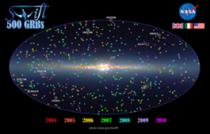Apr 21 2010
NASA's Swift satellite, whose science and flight operations are controlled from Penn State's Mission Operations Center in State College, Pa., has detected its 500th gamma-ray burst -- a type of explosion that is the biggest and most mysterious in the cosmos.
 Above, a map of the Swift satellite's 500 gamma-ray burst detections. Click on the image above for more photos and videos.
Above, a map of the Swift satellite's 500 gamma-ray burst detections. Click on the image above for more photos and videos.
Swift's X-ray telescope and ultraviolet/optical telescope were developed and built by international teams led by Penn State.
"Over its five years in orbit and its 500 gamma-ray-bursts detections, Swift has fulfilled every significant promise of its mission and, in addition, has brought a wealth of surprises," said Derek Fox, assistant professor of astronomy at Penn State and astrophysics and a Swift team member. The spacecraft's "burst-o-meter" cataloged its 500th gamma-ray burst on April 13.
"Swift has been remarkably successful, far exceeding our expectations for a mission that was originally going to last only two years," said David Burrows, Penn State senior scientist and professor of astronomy and astrophysics, the lead scientist for Swift's X-ray telescope, and one of the leaders of the Swift mission since its beginning.
The Swift satellite has given astronomers more discoveries than they could have hoped for, ranging from a supernova relatively near to Earth, in astronomical terms, to a blast so far away that it happened when our universe was only 5 percent of its present age.
"By catching 500 gamma-ray bursts 'on the fly' and studying them in unprecedented detail, Swift has given us a much deeper understanding of these elusive explosions and their role in shaping our universe," Burrows said. Among other things, gamma-ray bursts signal the death of massive stars and the birth of black holes.
Burst number 500, officially known as GRB 100413B, exploded in constellation Cassiopeia as a long burst, a type usually associated with the death of a massive star. It was recorded by the spacecraft's Burst Alert Telescope (BAT), whose data later were analyzed by David Palmer, an astrophysicist at Los Alamos National Laboratory in New Mexico.
"The BAT team regularly digs through the data once it comes to the ground and finds weak bursts like this one that take a bit of special care," said Judith Racusin at NASA's Goddard Space Flight Center, who coordinated burst observations that day. Racusin earned her doctoral degree in astronomy and astrophysics at Penn State.
Some of the other Penn State researchers who contributed to the milestone detection with Swift of its 500th gamma-ray burst include Peter Meszaros, the holder of the Eberly Family Chair in Astronomy and Astrophysics at Penn State, a Penn State professor of physics and the leader of the Swift Theory Team; John Nousek, Penn State professor of astronomy and astrophysics and Swift's leader for mission operations; and Peter Roming, leader of the Swift UV/Optical Telescope.
Gamma rays are the highest-energy form of light, and the brief but brilliant blasts result from a colossal energy release. Gamma-ray bursts (GRBs) were discovered in 1967 by unclassified military satellites designed to look for clandestine nuclear tests. The first observations required extensive analysis to be sure that the bursts were truly originating beyond the solar system, and they weren't published until 1973. Over the following years, astronomers learned that sufficiently sensitive instruments could detect about two bursts per day, on average, somewhere in the sky. Of those twice-daily GRBs, Swift's Burst Alert Telescope snares about one in eight for detailed study.
Astronomers scramble to detect afterglow from new GRBs as fast as they can. Afterglows in visible light provide information that confirms the burst's distances from Earth, and astronomers now regularly study afterglows across the entire electromagnetic spectrum. Most of the time, the hard task of measuring burst distances falls to ground-based observatories, which can target a burst's location with telescopes far larger than the Ultraviolet/Optical Telescope aboard Swift.
"Getting on the afterglows quickly with large ground-based telescopes remains a key element in understanding GRBs," said Fox, whose research focuses on follow-up observations. "It's this synergy between Swift and ground observatories that has really moved the ball forward, especially for short bursts and bursts that are very far away."
Swift has detected 75 percent of all the GRBs whose distances have been measured.
"Swift has seen GRBs as close as about 100 million light-years and as far away as 13 billion light-years," said Gehrels.
Put another way, Swift has detected gamma-ray bursts over a span of time equivalent to about 95 percent of the universe's age.